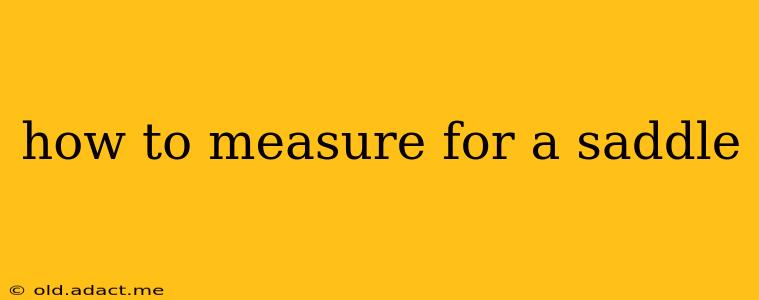Finding the right saddle is crucial for comfort, performance, and preventing injury. Improper saddle fit can lead to pain, numbness, and even long-term health issues. This comprehensive guide will walk you through the essential measurements and considerations to ensure you find the perfect saddle for your needs. We'll cover everything from basic seat bone width to more nuanced considerations like saddle shape and overall riding style.
What Measurements Do I Need to Take for a Saddle?
This is often the first question riders have. The most important measurement is your sit bone width, but other factors are equally important. Let's break it down:
1. Sit Bone Width Measurement:
This is arguably the most crucial measurement for saddle selection. Sit bones (ischial tuberosities) are the two bony points at the base of your pelvis. An accurate sit bone width measurement helps determine the appropriate saddle width to provide adequate support and prevent pressure on soft tissues.
How to Measure Your Sit Bone Width:
- Gather your materials: You'll need a piece of stiff cardboard or thick paper, a marker or pen, and a ruler or tape measure.
- Prepare your surface: Sit on the cardboard or paper with your legs slightly apart, as you would on a bicycle.
- Mark your sit bones: Shift your weight slightly to ensure even pressure on both sit bones, then carefully stand up. You should see two distinct indentations on the paper/cardboard; carefully mark these points.
- Measure the distance: Use a ruler or tape measure to accurately measure the distance between the two marked points. This distance represents your sit bone width in centimeters.
Important Considerations:
- Clothing: Wear the type of clothing you would typically ride in. Thick clothing can affect the accuracy of your measurement.
- Posture: Maintain a natural riding posture during the measurement process. Slouching or leaning can impact the accuracy.
- Multiple Measurements: Take several measurements to ensure accuracy.
2. Saddle Length:
While not as critical as sit bone width, saddle length significantly impacts comfort. A saddle that's too long can cause pressure and discomfort on your perineum and soft tissues, whereas a saddle that's too short may not provide adequate support. The correct length offers enough support without restricting movement.
How to Determine the Right Saddle Length:
- Consider your torso length: Riders with longer torsos often benefit from longer saddles, while riders with shorter torsos might find shorter saddles more comfortable.
- Experimentation: Many manufacturers provide saddle length recommendations based on sit bone width. Experimentation may be necessary to find the optimal length.
3. Saddle Shape:
Saddle shape is closely linked to riding style and personal preferences. Different shapes provide varying levels of support and pressure distribution:
- Rounded Saddles: Often preferred for comfort on shorter rides and upright postures.
- Flat Saddles: Tend to be popular amongst cyclists who prefer a more aggressive riding position.
- Cut-Out Saddles: Designed to relieve pressure on the perineum and improve blood flow, particularly beneficial for long rides.
What is the Best Saddle for Me?
The "best" saddle is subjective and depends on numerous factors, including your riding style, preferences, and body type. Don't solely rely on a single measurement; consider these additional factors:
Riding Style:
- Road Cycling: Often necessitates a more aggressive riding posture, calling for saddles designed for aerodynamic efficiency and pressure relief.
- Mountain Biking: Demands saddles that are durable and offer better grip and stability.
- Gravel Riding: Often blends elements of road and mountain biking, requiring versatility and comfort.
Personal Preferences:
Comfort is subjective. What feels comfortable to one rider may not feel comfortable to another. Experimentation and feedback are key.
Trial and Error:
Don't be afraid to try different saddles! Many bike shops offer test saddles or return policies, allowing you to find the best fit for your unique needs.
How Often Should I Measure for a Saddle?
Body composition can change over time, so it's a good idea to re-evaluate your saddle fit every few years, or sooner if you notice any discomfort or changes in your body shape.
By carefully considering your sit bone width, saddle length, riding style, and personal preferences, you can significantly improve your riding experience and comfort. Remember, finding the perfect saddle might take some time and experimentation, but the investment in comfort and injury prevention is well worth it.
